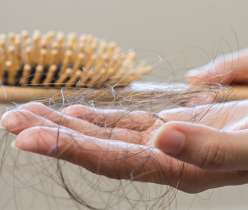Androgenic alopecia is pattern baldness. It can occur in both men and women. In today’s time of pollution and unhealthy lifestyle, this is very common in people. Hair loss begins with well define pattern, beginning above both temples. With passing time, the hairline recedes to form a characteristic “M” shape. Hair starts getting thin at the crown (near the top of the head) and often progressing to partial or complete baldness. Almost all patients with androgenic alopecia have an onset prior to age 40 years, although many of the patients (both male and female) show evidence of the disorder by age 30 years.
The pattern of hair loss in women differs from male pattern baldness. In women, the hairline does not recede, but hair becomes thinner all over the head. Androgenic alopecia in women rarely leads to total baldness.
Sometime androgenic alopecia in men has been associated with several other medical conditions including coronary heart disease and enlargement of the prostate. This disease can be sometimes the symptom of some underlying severe medical condition. In women, this condition can sometimes be associated with an increased risk of polycystic ovary syndrome (PCOS). PCOS is characterized by a hormonal imbalance that can lead to irregular menstruation, acne, excess hair elsewhere on the body (hirsutism), and weight gain.
There are various genetic and environmental factors which can trigger androgenic alopecia in men or women. But most the factors associated with alopecia are unknown. The hormone androgen relates to this disease. Androgens are important for normal male sexual development before birth. Androgens are very important in both males and females as they help in regulating hair growth and sex drive.
Inheritance pattern- the inheritance pattern of androgenetic alopecia is unknown as it is triggered by many genetic and environmental factors. This disease tends to cluster in families, however, and having a close relative with pattern hair loss appears to be a risk factor for developing the condition.
Diagnosis-
There are various ways for the diagnosis and management of the disease. There are some tests such as prenatal testing, biopsy, CT scans, etc., which can easily diagnose the disease and help in disease management. Genetic testing is also used for the diagnosis of the androgenic alopecia. A doctor suspects a diagnosis of a genetic condition on the basis of a person’s physical characteristics and family history, or on the results of a screening test. There are trichoscopy, biopsy, and histology also for the diagnosis of this condition.
Treatment-
Medication- hair loss can be slowed or reversed in its early stages with drug therapies if diagnosed properly. There are various drugs available for the treatment of this condition-
- Androgenic dependent- finasteride and Dutasteride are used for the treatment of androgenic alopecia. Finasteride is a drug the 5-α reductase inhibitor class (5-ARIs). By inhibiting type II –ARI, finasteride prevents the conversion of testosterone to dihydrotestosterone in various tissues including the scalp. This leads to prevention of hair loss and hair growth can be seen within a few weeks. Dutasteride is a drug which inhibits both types I and II 5-alpha reductase.
- Androgenic independent- there are drugs such as minoxidil, tretinoin, alfatradiol, and topilutamide which dilates small blood vessels.
- Dietary supplements- there are various vitamins, minerals, or other dietary supplements which can be used for the treatment of androgenic alopecia.
- Laser treatment- many doctors prescribe laser treatment for the treatment of male pattern baldness.
Prevention
There’s no known way to prevent male pattern baldness. A theory is that stress may cause hair loss by increasing the production levels of sex hormones in the body. So this can be prevented from participating in relaxing activities such as walking, listening to calming music, and enjoying the more quiet time. Follow a healthy lifestyle, such as doing exercise regularly and avoiding unhealthy food habits and avoiding junk foods. Washing your hair with regular intervals and nourishing the hair and scalp with good oil, this can’t stop hair loss but can prolong the life of hair.



